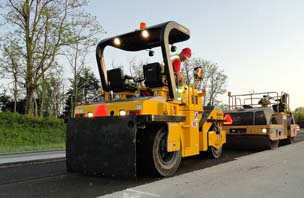The Virginia Department of Transportation has realized cost and energy savings using recycled asphalt paving processes for a repaving project along a portion of Interstate 81, prompting the agency to consider broader use of the technique across the state.
The VDOT project repaved a 3.7 mile southbound section of the I-81 using pavement processes that reuse existing material from the road surface in the new pavement structure, reducing construction time by about two-thirds and saving millions of dollars, according to an announcement from the office of Governor Bob McDonnell.

Asphalt pavement recycling on I-81. Source: Virginia DOT
The paving processes are known as cold in-place recycling, cold central-plant recycling, and full-depth reclamation. The project was the first time that the three processes were used together in a single interstate project in the country, according to VDOT. “Cold” refers to processing at ambient temperatures rather than using heat, according to VDOT’s project description. The recycling was done both within the roadbed and next to the highway.
Due to differences in the level of deterioration, different processes were used for the right and left lanes. After the top 10 inches of pavement were removed from the right lane, the aggregate between 10 inches and 22 inches below the surface was recycled in-place using the full-depth reclamation process. A stabilizing agent called Calciment was added. In the meantime, the pavement from the top 10 inches of the right lane was milled and processed next to the highway using the cold central-plant recycling process. The layer was then reapplied using traditional paving equipment. Finally, the right lane received a surfacing of four inches of hot-mix asphalt.
The left lane, having less deterioration, was recycled in-place to a depth of 5 inches using the cold in-place recycling method. With this process, the front of the machine mills the existing pavement, moving the milled material to the middle of the machine where the asphalt is stabilized and a binding agent is added. The reconstituted asphalt is then applied back to the roadbed. The three stages of the process occur in one pass. The left lane was also topped off with hot-mix asphalt.
Substantial Savings
Savings on the I-81 in-place pavement recycling project go beyond time, money, and materials,” according to VDOT Commissioner Greg Whirley. He cited fuel savings, reduced work-zone congestion, and reduced maintenance as additional benefits.
Using conventional methods, the project would have taken two years or more to complete, requiring lanes to be added to accommodate traffic during construction, according to Mal Kerley, chief engineer at VDOT. These methods would have cost around $40 million, Kerley said.
VDOT looked at six different options for this project and considered the benefits of doing major reconstruction rather than short-term “band aid” fixes, which would require additional ongoing maintenance.
The announced contract award amount for the option VDOT chose was $7.64 million and was completed in about seven months using the new processes. Kerley said the agency anticipates that the processes will be as adequate, in terms of durability, as traditional processes.
Traffic Management Techniques
The project also employed a new traffic management plan to handle vehicle traffic during construction. Truck traffic was routed to the right or left lane when the adjoining lane was being repaired, while passenger vehicle traffic was detoured off of the interstate. Use of a detour at all was unprecedented for such a busy travel corridor, Kerley explained.
VDOT made an effort to get the word out of the dates and routes of the detours along the corridor, Kerley said. VDOT also used changeable message signs, traffic cameras linked to the internet, and warnings of traffic backups using an advance warning vehicle and notices to trucks over CB radio.
VDOT recognizes that the trend in highway project management is to help the public make informed decisions and “minimize the impact to the traveling public,” Kerley said.
Governor McDonnell also highlighted plans to use pavement recycling processes in future projects to save time and money. “Using these pavement recycling methods has the potential to revolutionize how we rehabilitate our aging roads, both in Virginia and nationally,” the governor said in a statement.
VDOT will be working with district offices and the Virginia Center for Transportation Innovation and Research to develop standard specifications for this kind of rehabilitation work in the future, Kerley said. He noted that there are one or two more projects planned for 2012 that will use the pavement recycling methods.
VDOT is “trying to standardize this [type of project] so it is another tool in our toolbox,” Kerley said.
The Asphalt Recycling & Reclamation Association presented VDOT with its 2012 Recycling Award in the “Cold In-Place” category for the project.
More information about the project is available here.